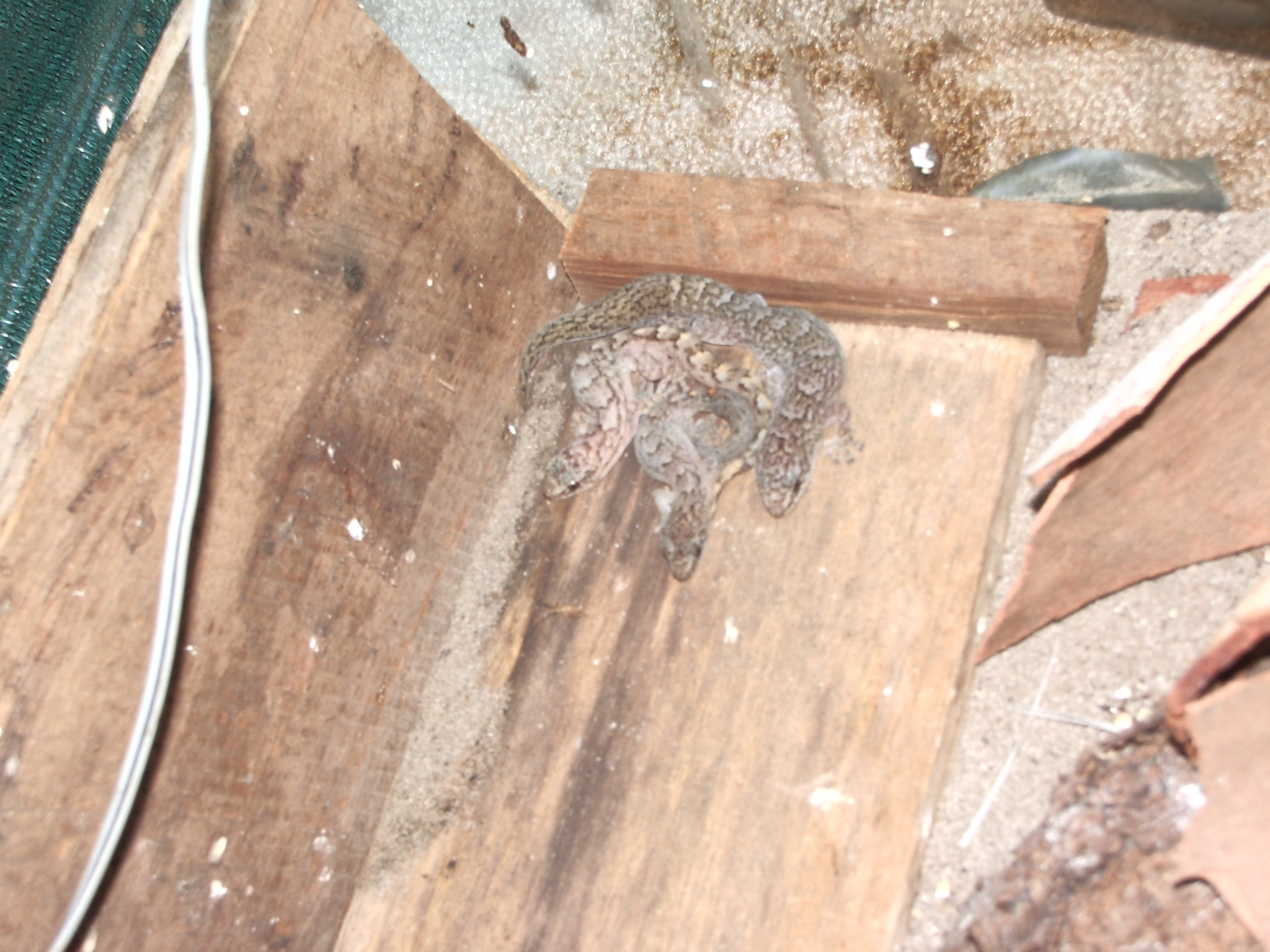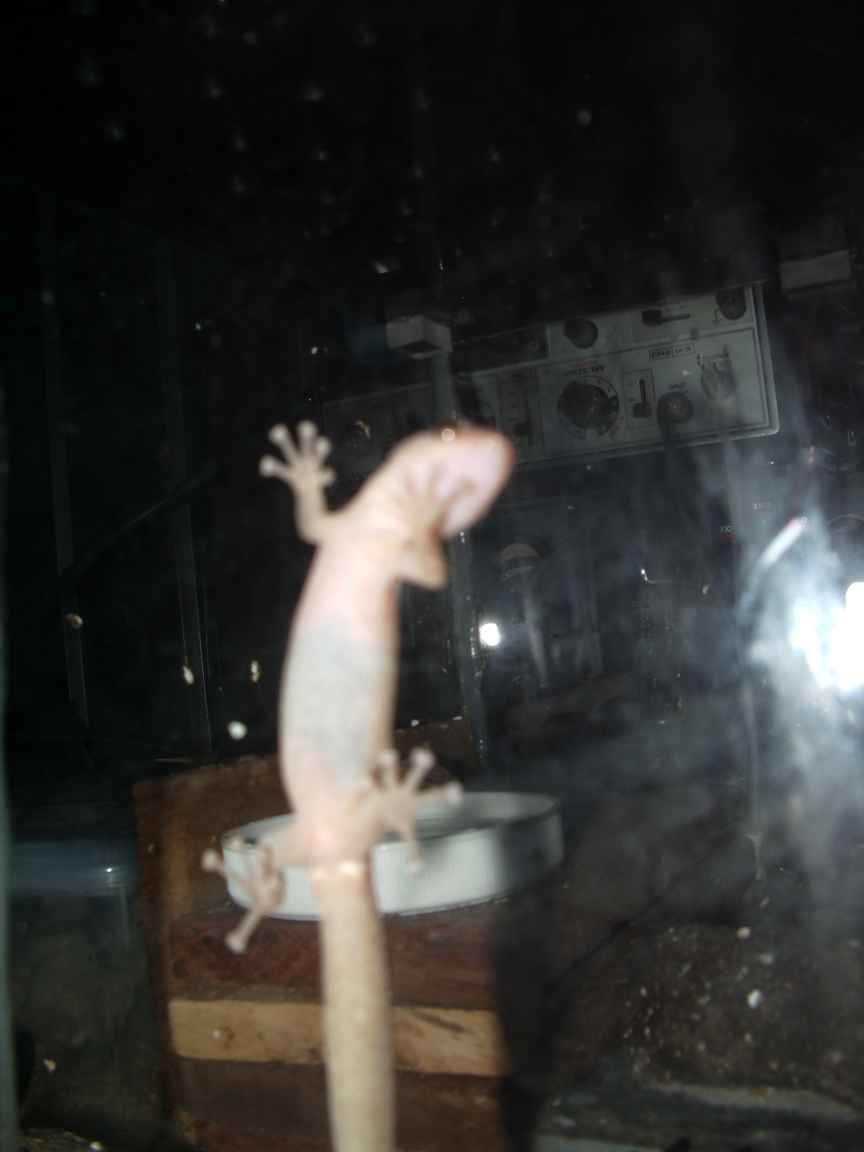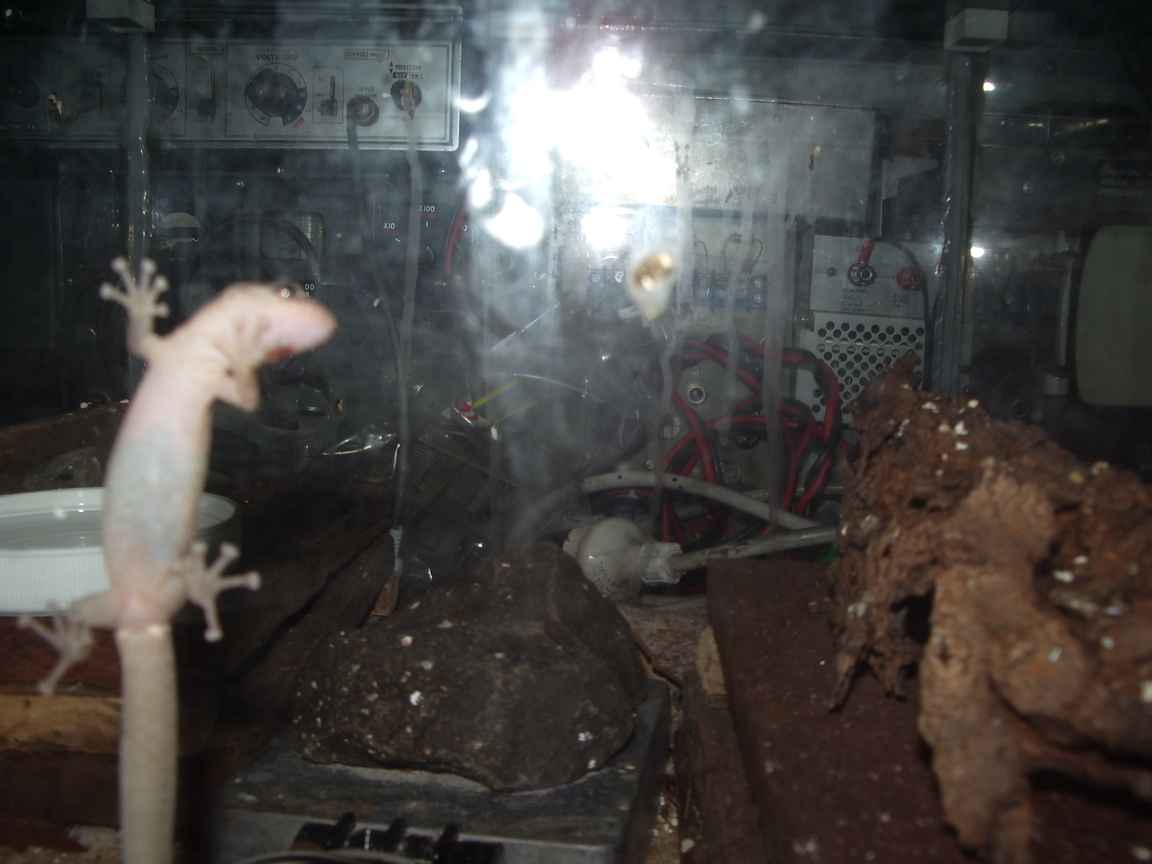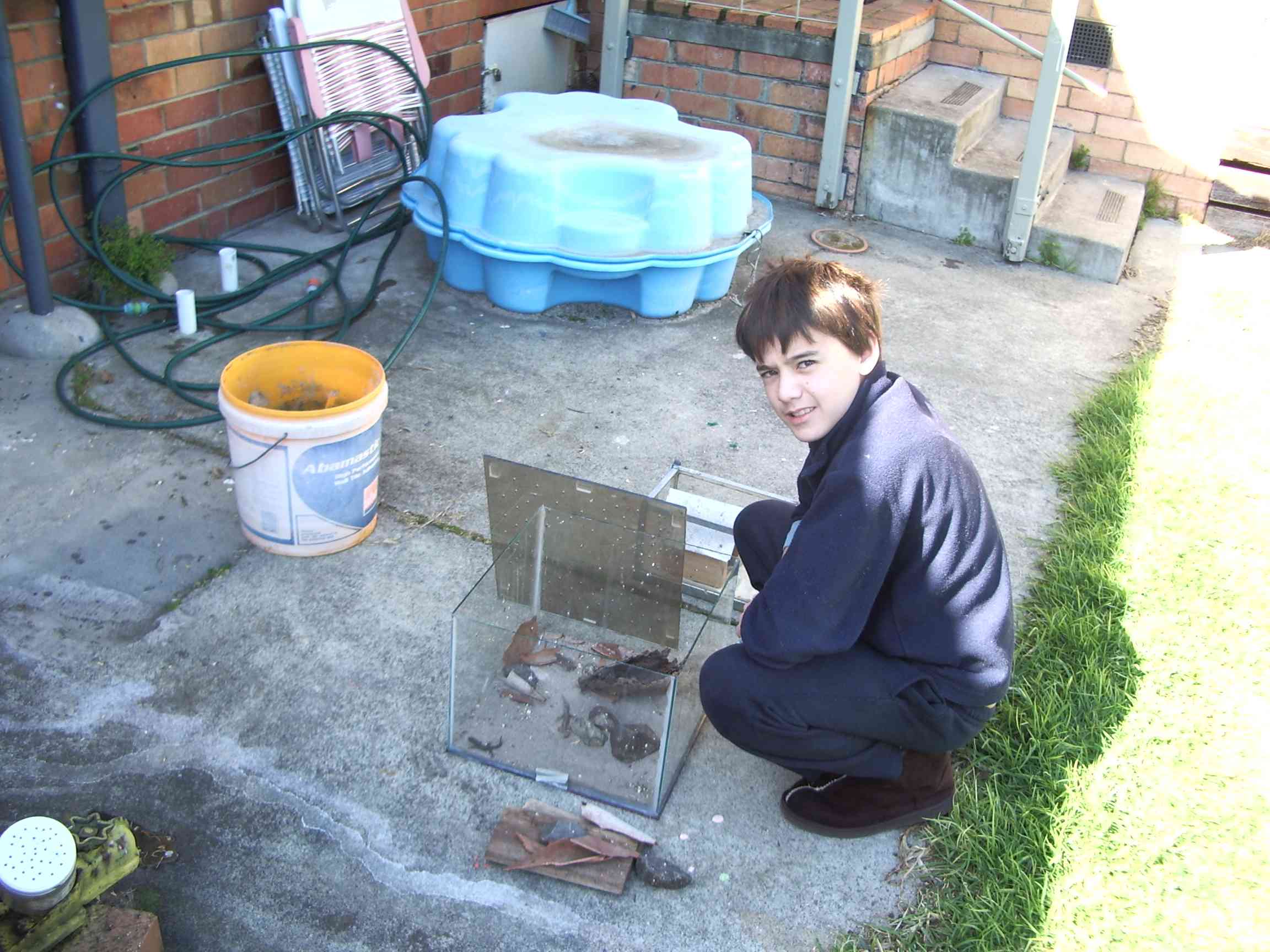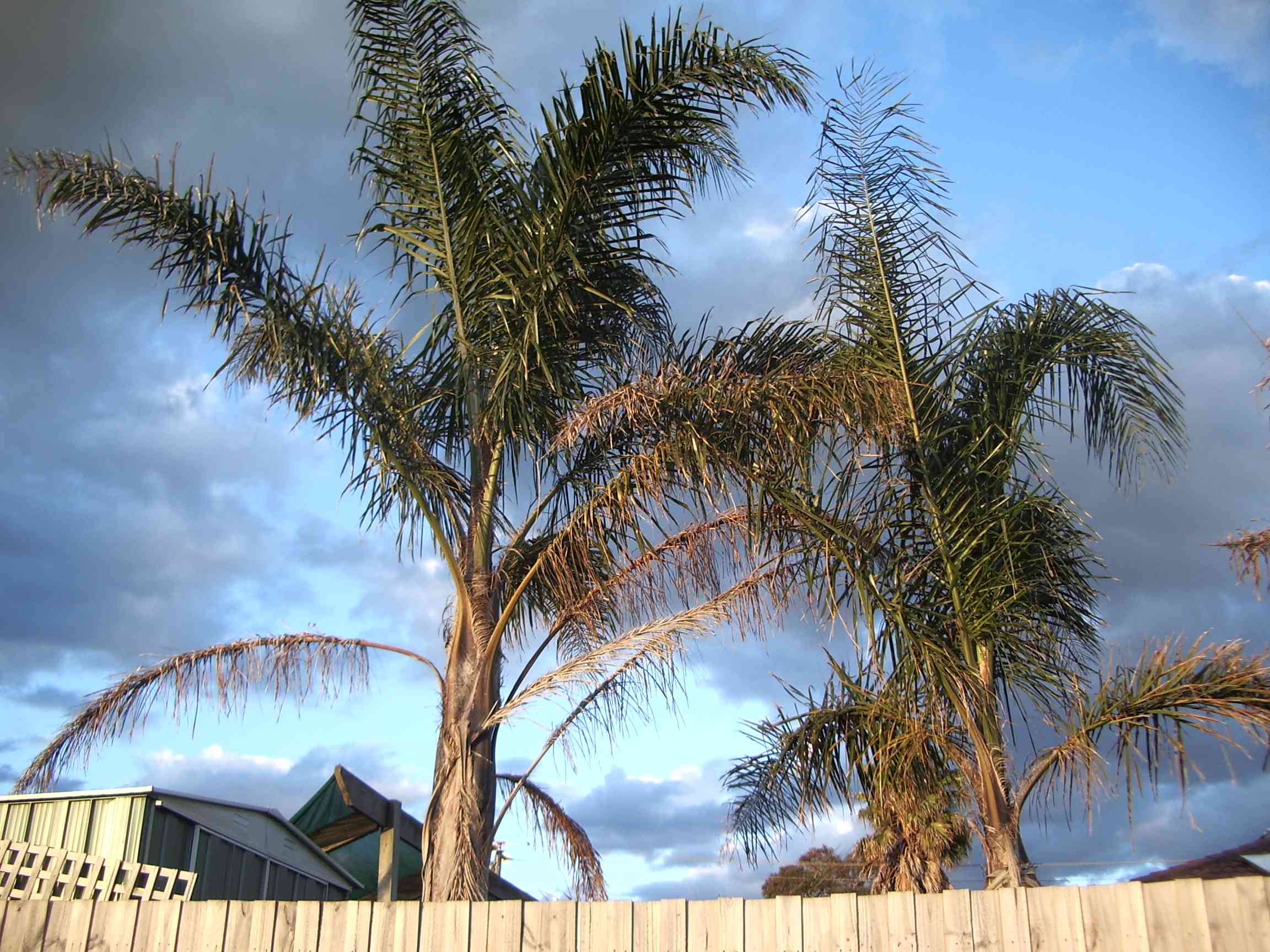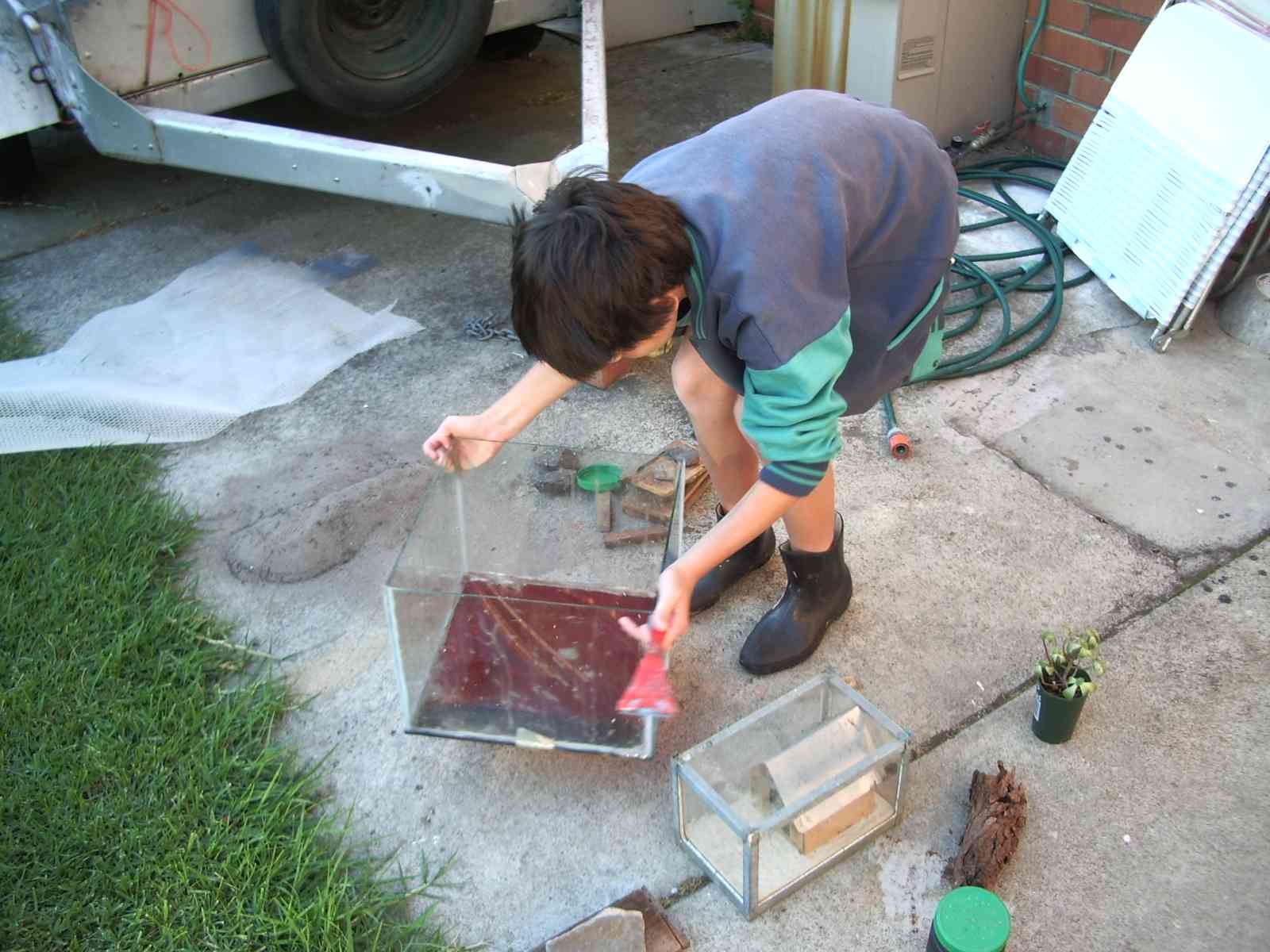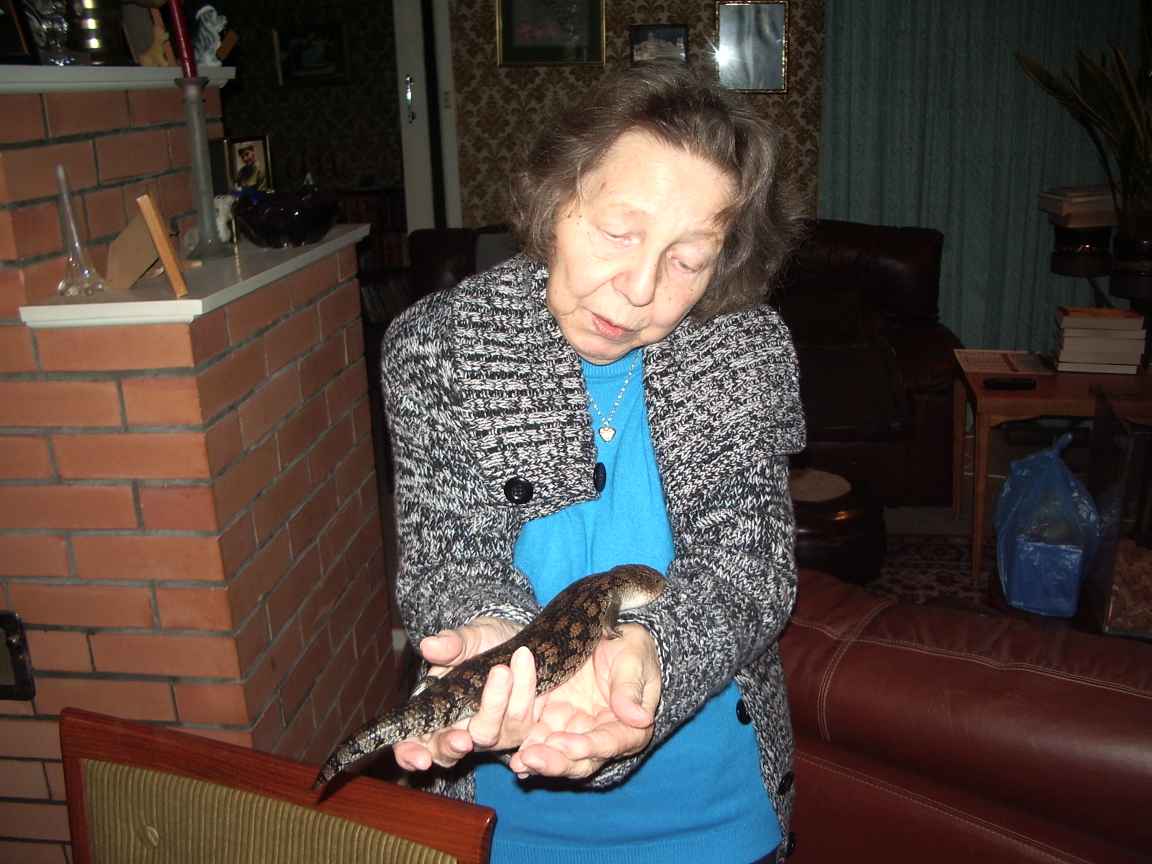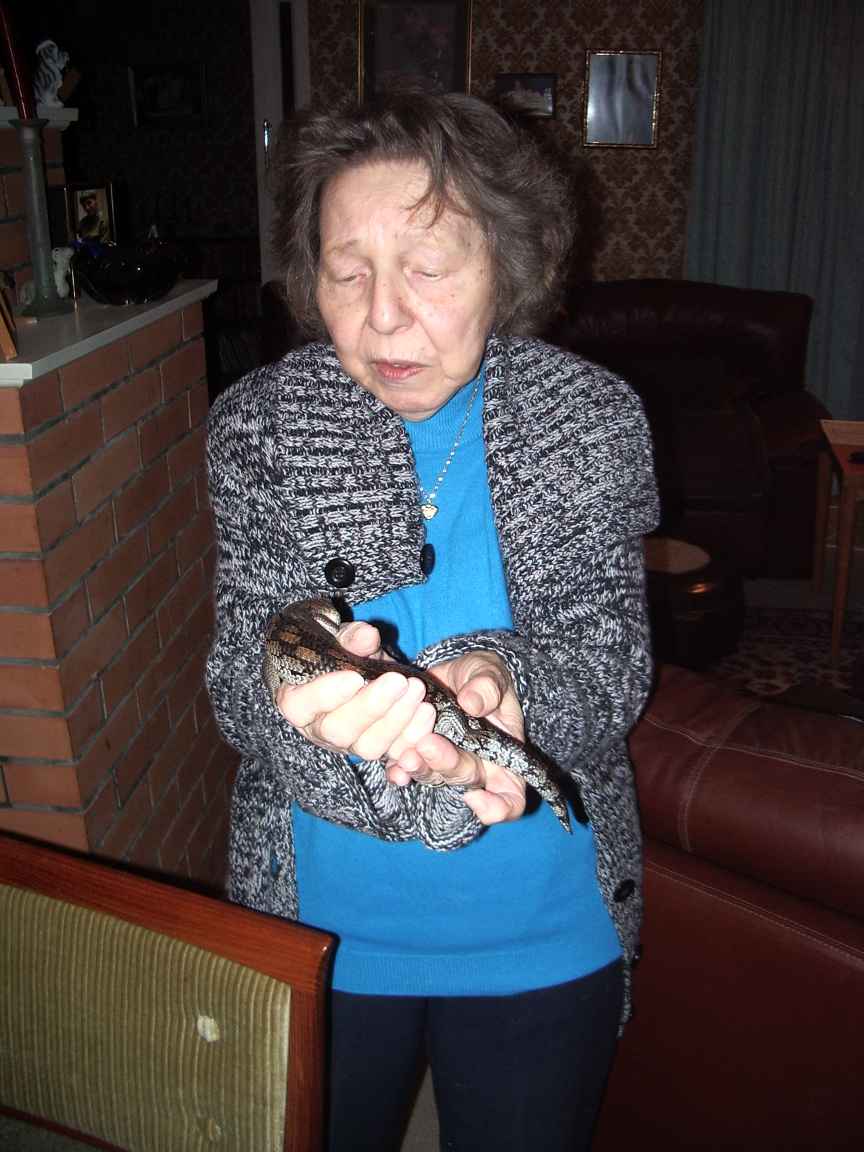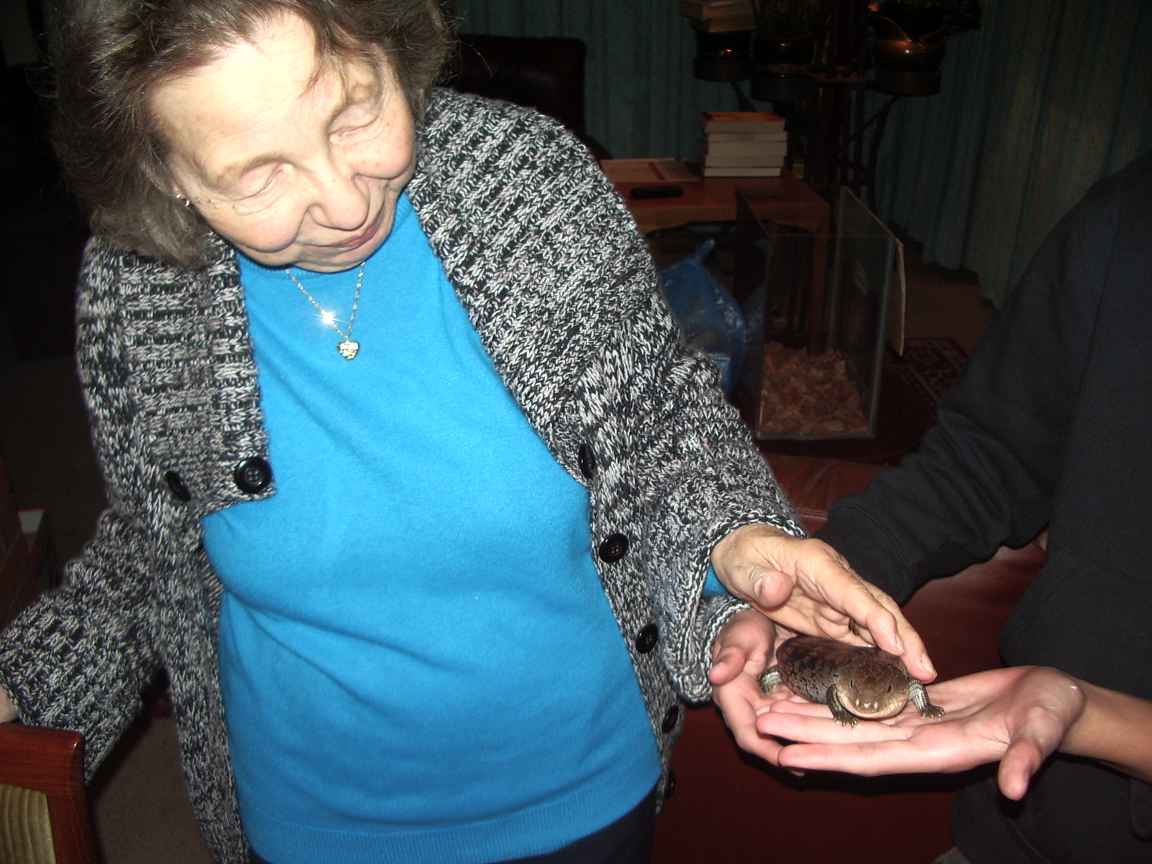copyright
declaration: My text and pictures are copyleft, you are free to use
them for all reference, academic, archival or journalistic purposes.
The extract from A.E.Greer's article does not belong to me,
copyright belongs to A.E.Greer.
This attractive little creature is
sometimes on sale at Melbourne assorted
reptile pet shops. They are fairly low in cost and are rather
unpopular. The reason for this disparity is because these little
reptiles are strictly nocturnal and the store enclosures always look
empty. This is because they are hiding! They are pathologically shy of
light and will only emerge from their shelter when it is nearly dark to
hunt. They will live up to five years and do not appear to stop
growing. Color and skin markings differ from allmost
completely
black to a light brown, sometimes with distinctive orange bands. The
camoflage pattern is superb, they are allmost invisible against coarse
tree bark. The eyes have a beautiful golden metallic sheen.
Housing the gecko.
The geckos' foot pad is a miracle of nano molecular materials engineering. The
laminae on the pads terminate in monomolecular filaments and are
attractive to nearly all surfaces by molecular van-der-vaals forces.
The attractive power of a gecko footpad, if all micro hairs were
engaged to the surface has an attractive force estimated at over
10000kgs per square centimetre. This is better than super glue. The
gecko foot pad is the reason that your enclosure must be fully
enclosed. It is an amazing thing to watch a gecko run up a shear piece
of polished glass and even hunt when suspended upside down against
glass. (watch...
the footpad will not stick to teflon, we have tried this at
home!) The ventilation holes must be numerous and if there is any hole
larger than 5mm they WILL escape.
The southern marbled gecko ranges into southern Victoria and seems to
be able to cope with the cold weather. In the wild it inhabits rock
creavices and tree bark where it coexists with very substantial size
spiders . At sun down they emerge to hunt, warming
themselves on the absorbed heat of the rock or tree surface that has
been facing the sun. They will hunt, get cold, return to a basking
position and continue hunting until the basking spot cools. In
Melbourne this mean on a typical day they have about an hour to get a
meal before they return to hide out the night. Your enclosure should be
facing sun, but behind shade cloth, else they will get cooked on a hot
sunny day. Put large rocks in the enclosure and this will help
stabilise the temperature and make them feel at home. One cubic foot of
volume will happily house up to 6 adult geckos without rancor.
The enclosure should be glass, to help you keep it clean, as they will
foul the sides during their nocturnal hunt. The floor should be perspex
for safety and resilience. The lid should be heavy or firmly attached
and must be well ventilated. The gecko is very shy and must have good
hiding places or it will become distressed and not thrive. Bind
together layers of tree bark, they love this as it mimics their true
habitat. The floor of the enclosure should be a mixture of coarse sand
and small stones. They will lay their eggs into the sand during
breeding season. Include small rocks for visual appeal and temperature
stability. During the winter months it is good to gently heat
the
enclosure. I biult into a die cast box a ten watt resistor
and it
gets powered from a plug pack to provide an average power of ten to
fifteen watts. The geckos will bask on this to warm up during their
evening hunt. This is not needed in summer months, but they do
appreciate
it when it gets cold.
When you change the sand in the enclosure be on the carefully lookout
for
eggs which the female will bury one centimeter below the surface. The
eggs are about 1.5cm long and pure white. The eggs will hatch
in
about ten weeks. A live egg will be slightly opaque and
heavy, a
dead egg will bleach and be very light to the touch as its insides
evaporate. Return the eggs to the same aspect where you found
them, the female has selected the spot for its average temperature.
The female does not appear to form a long term attachment to
the
egg site.
Feeding the gecko.
I am note sure what they actually eat in the wild. I suspect it is
mainly small spiders. They have ignored most garden insects I
have offered them. The one insect they will eat are the small crickets
sold by reptile shops. If they are really hungry and dont see you
watching them they will actively hunt them in diffuse daylight. The
right diet seems to be about one cricket per day but this
does
depend on the season and the temperature. I am not sure about meal
worms, I have tried them but I have not actually seen them being
eaten. You also need to look after your crickets, they are
living
creatures too. Like most other reptiles, their appetite declines in the cold
season, so dont worry if they seem to have gone off their food.
I was not sure how to feed hatchlings. They have been
uninterested in
the smallest crickets they were offered. After two weeks we returned
them to a pile of bricks from where their parents were captured. We
found them grown up six months later. They had to deal with hungry
birds, ravenous spiders and other challenges. They were able to find
their own dinner, which I think could have been small spiders and
springtails, small shrimp like creatures that live under decaying
vegetation. Now , we do know. They will not eat for about two weeks
after hatching, after that they will accept "small crickets".
I
have observed with a microscope the dung of the wild woodpile geckos. Their
natural diet appears to consist of spiders (fangs), small beetles (wing
cases)...probably cockroach nymphs and some evidence of flys (fly
wings).
Our
latest hatchlings have now taught us how to feed them. Do
nothing, leave them in their own private enclosure where they can learn
to hunt small crickets. They appear to show no interest in hunting for
about 2 weeks, but naturally they must have fresh water. They
must have a private enclosure as the adults will deprive them of food.
They will grow very rapidly with a private food supply. Leave a
teaspoon of rolled oats in their private enclosure, this will keep the
small crickets alive until eaten.
It is natural to assume the gecko gets its water requirement from its
prey but even so, always provide them with a shallow container of
fresh water. I have now seen a gecko deliberately drink , they will
lick the surface of the water with their long tongues. It is very rare
to see this and I have only seen it once in the last 3 years.
The academic paper from "Greer, A.E. 2006. Encyclopedia of
Australian Reptiles. Australian Museum Online", suggests that they take
fruit flies and small house flies but I have yet to see this. My
problem with this is capturing and then introducing flying insects
into a practical gecko enclosure. There are certainly less flies
around Melbournes' suburbia compared when I was young and actually
finding a fly to capture cannot be done "on demand".
handling the gecko.
This Gecko is a very shy creature. Avoid handling it to avoid
distress. A distressed gecko will shed its tail quite readily. When you
do need to handle it have a darkened container to transport it or to
temporarily store it while you muck out its enclosure. I have
had
some geckos actually become finger tame but that is exceptional. A
gecko
that has shed its tail will regenerate it in about 8 months. Most
geckos that I have observed outside have regenerated tails so it
appears to happen often in their little lives. If your gecko does shed
its tail, leave it with the animal. It is said they will eat it,
allthough I have never observed this. I have found the most
effective way to capture a gecko is to goad it into a black painted
container which it will happily enter. If you must pick it up , cup
your hands to make a dark cavity and do not apply pressure. Put it in a darkened container immediately. It will
remain calm in the dark.
Some geckos are very
aggressive and will rear up and strike you as would a snake. These
more aggressive specimens generally dont have regenerated tails ! Our
favorite gecko
"Grump" is a girl, very large for a Christinus marmoratus, and pretends
it is a
deadly snake ! The gecko will move with great speed and agility and
will dive into the air to escape you. Recapturing an escaped gecko is
extremely difficult, they are not afraid of heights, sheer walls or the
dark. Dont loose it, you will probably never see it again.
Observing your gecko.
Now that is hard, they are pathologically shy, dark seeking, agile and
strickly noctural. having gone to the trouble of feeding, housing and
warming them it is only natural that you want to show them off and
perhaps even watch them hunt. I have had to resort to
setting up a security camera with infra red illuminators (they are not
sensitive to IR light). If they are warm they are very active, hunting,
contesting for territory or just hanging about on the glass. But all
this in the dark. They are like fairies, if they see you
watching , or sense your movement, the
performance is over.
Gecko social behaviour.
They are notionally solitary animals. They do abide their own company
and when they are cold they will huddle together in some
favoured
hiding place in bark or under a rock. In the breeding season they will
contest for loosely held territory, the females for good spots to lay
their clutch of two surprisingly large eggs. My enclosure
contains a small succulent pot plant with sandy soil and the females
really like this. I believe that it is safe to leave the hatchlings
with the adults, I have seen no evidence of cannibalism.
yes, now I have seen cannibalism The
hatchlings
are surprisingly large. It seems hard to accept that so much gecko can
be contained in their little eggs. Geckoes caught wild can range in
behaviour from rather passive to extremely aggressive. The aggressive
ones will strike an "enemy" finger offered to them like a snake. They
curl into a S curve and lunge forward with surprising force, perhaps
enough force to frighten off a blackbird and the snake like behaviour
could be an evolved defensive mimicry. Some geckos will become
sufficiently finger tame that they may be removed from their enclosure
and exhibited. Have your guests pull up their sleeves as a gecko that
may panic will dash into the nearest dark space, which would be a
guests sleeve! Most of the worlds geckos vocalise. Sometimes
we
think we hear a high pitched chirp, but these animals are
regarded as silent. It is possible that their vocalization could be
supersonic. One day I shall set up a microphone and oscilloscope to
test this idea. It is rare to see overt aggression, recently
however we observed two geckos in a life-n-death struggle, followed by
the active tracking and persuit of one by its constestant. Was
this mating behaviour ? It did not look very friendly. We still
really havenet learned to distinguish male from female, except when
gravid.
Canibalism.
After
some 6 years of observation I can state that cannibalism does occur. It
is extremely rare. Two hatchlings were partially eaten by a mature,
large and aggressive female. She was ejected, (in disgrace!) back
to the woodpile where she was first found.
finding geckos
in Melbourne.
The southern marbled gecko is actually common, your house may have
geckos living under eaves and biulding crevices. Look for the
droppings,
the dung looks like sparrow droppings, black,thinner than mouse
droppings but capped in a white crystalline excressence in impossible
situations, like upside down under an eave. You could have geckos for
years but never see one due to their survival behaviour as described.
The pressence of geckos could be indicated by an absence of brown
house spiders in places and crevices where they might otherwise be
found. If you have a pile of house bricks that face the afternoon sun,
take the pile apart carefully, you might be rewarded. Our favourite
gecko "Grump" appeared to have been trapped in the small concave cavity
in a house brick that was resting against the flat surface of its
neighbour. She had grown very large in this cavity and I dont believe
would have been able to leave it. This possibly explains her bad
temper! If you have an outdoor wood pile of
parallel
boards that gets afternoon sunlight, again look carefully, there may be
a gecko in the space between planks. There will be an absence
of
small spiders, only some very large ones that the gecko cannot tackle.
Late afternoon sun exposure seems to be the key for finding
gecko habitats, and I would guess in Southern Victoria's "cold" climate, late afternoon sun exposure is mandatory.
Look behind tree bark, I have not actually found any on the eucalypt
trees in my neighbourhood, the spiders to be found there suggest that
no other life forms are possible and are welcomed only as dinner! The
premier place where I can guarantee finding one is in front to trunk
cavity of palm trees, in particular the large palm trees of the Kocos
Palm variety that have a very large flat area of dead frond,
thats enclosed at the bottom so it collects water, dirt and insect
detritus and many spiders. Geckoes love this habitat. If you
have
one of these larger palm trees in your neighbourhood you will have
geckos. In this habitat they are totally protected from birds. If you
have this tree in your garden do not remove all the dead fronds, by all
means trim off the dead frond but leave in place the bit that
wraps around the trunk, this will attract, breed and maintain the gecko.
Melbourne reptile shops sell these animals for about $40 each. They
are not very popular because of their pathological shyness and their
propensity to escape. They will also sell you a good fully sealed
enclosure. I have recently noted the local reptile shop selling
the so called "Horned Gecko" which make better display animals. These
are not frightened by light and will hang about on the glass of their
enclosure.
More work colleagues are telling me that they find this gecko
whilst doing building work that exposes their retreats. They appear to
be fond of weather-board construction, which makes perfect sense. These
anecdotes are pointing to the eastern suburbs.
finding a lost geckoSometime
about half a year ago, Grump-the-gecko managed to escape. We dont quite
know how, but Grump was a powerfull little animal and may have
succeeded in lifting the lid on the enclosure. We could not find it in
the house, that did not come a a surprise, because unlike a lost pin, a
gecko does not WANT to be found. At least a pin, once lost in the
haystack, will not actively seek out an even darker corner to hide in!
A gecko hiding in the corner basically just looks like more
corner !
I was demolishing part of an external wall, and had seperated a
large sunward facing board from the house. There was Grump ! who had
been living quite happily, it would seem, in this narrow crevice ,
eating house spiders. Grump was not happy to see me again but has
rejoined her cousins in the enclosure. Grump confirmed one
suspicion of mine. The only real food available here were small brown
house spiders and juvenile white-tailed spiders of which we have more
than our fair share. In this particular area there was a
noticeable absence of smaller spiders, only fully grown mature
specimens. The gecko had even left its droppings in a totally dark and
invisible space. It was easy to loose site of the fact that Grump
was a wild animal and quite capable of looking after herself, something
one tends to forget after years of care. She is still just as bad
tempered and still lunges at and bites your finger, sometimes emitting
a little hiss. She still has her original tail, so outright
aggression/bluff looks like a usefull behaviour for this little
animal.
legalities
The Southern Marbled Gecko is currently not protected by law, no
license is required to acquire and keep them.
The Museum of Victoria lists this animal as "common" especially in the Eastern side of Melbourne.
frequently asked questions
This
paragraph was added to address the many frequently asked questions that
I get at my email address , below. I am currently recieving about one
enquiry a day from people that have encountered this little lizard for
the first time in the greater Melbourne and now Geelong area. The range
of this animal is expanding and this is being reflected in the
increasing volume of email enquiries.
will you answere email questions?Yes, the email address is valid, I will endevour to answere all questions. Never feel shy about asking.
I found this little lizard on the wall, what should I do with it ?Unless you are serious about keeping it, and it is one that you can
legally
keep, return it outside where it belongs. It is perfectly capable of
looking after itself. In keeping this little reptile you accept
responsiblity for feeding it, which, believe me, is expensive.
Is this lizard safe to leave in the house?Yes,
you and your house are safe from this gecko. However, this little gecko
is not safe from you or your house ! The gecko entered your house
through a ventilator, external crack or under the door. Its instinct is
to seek out crevices where its insect prey can be found. Most houses
and kitchens simply do not have sufficient insects or freely accesible
water around to keep the gecko alive. Unlike Asiatic and tropical
geckos, it will not gather around light bulbs catching flies; it is too
shy. Gently return it outside.
Geckos are not venomous. If you cannot bear the thought of touching it, goad it into a dark cardboard box and put it outside.
Does it carry diseases ?Reptiles
are not generally known for harboring pathogenic organisms dangerous to
humans. It is safe to touch and handle but the usual rule about
handling animals applies, allways wash hands after handling. They will
not foul your food, or enter a pantry except in the persuit of insect
pests! Given that the main diet of tropical house geckos are
flies, baby cockroaches and mosquitoes they have probably prevented
more deaths from malaria, in the households that tolerate them,
than any other artificial solution.
Can I keep it ?Yes,
The Southern Marbled Gecko is not protected, no DSE licence is
required. Think carefully about the responsibility that comes with
keeping an expensive to feed wild animal.
I want to let my captured gecko go, where is the best place ?Palm
tree if you have one, tree with loose sheetlike bark, woodpile,
brickpile or "just outside in the garden". Anywhere that they can hide.
Birds and cats find them attractive (for dinner!).
Two
eggs laid by the one female. These were discovered in early
December 2007. We think from past experience the gestation time is
about 15 weeks but we shall see. The eggs have a hard calcified
shell with a distinct crystalline texture. They are always laid
in a shallow burrow in sand. Be carefully when mucking out your
enclosure, you might have viable eggs.
Best site that I have yet found for reference material related to all Australian Reptiles ,The Australian Museum, Sydney
http://www.amonline.net.au/herpetology/research/
The following is a
literal extract from the excellent work of A E Greer.
Follow the link to the
Australian
Museum. The entire set of documents contains all you could possibly
want to know about Australian Reptiles presented as formal academic papers.
The citation as requested by the author follows:
Greer, A.E. 2006. Encyclopedia of Australian Reptiles. Australian
Museum Online
http://www.amonline.net.au/herpetology/research/encyclopedia.pdf
Version date: 7 August 2006.
===========================================================================
Christinus marmoratus
Distribution. The species ranges along the southern parts of the
mainland from northeastern
New South Wales to southwestern Western Australia. It occurs on a
number of small off-
shore islands including in South Australia, Greenly I. (King and Rofe,
1976), Hopkins I.
(Hudson, 1981), Kangaroo Island (King and Rofe, 1976) and Pearson I.
(King and Rofe,
1976) and in many islands in Western Australia, (Storr, 1987).
In the Western Australia, the species extends further north along the
coast than it does inland
(Storr, 1987: fig. 3), presumably in response to the cooler
temperatures due to the proximity
to the sea.
The species' distribution in New South Wales based on voucher specimens
in the collections
of the Australian Museum is shown
in the accompanying map.
Habitats. The species occurs in a
variety of habitats including open
shrubland (Kearney, 2002),
sclerophyll forest (Daniels et al.,
1986) and riverine woodland (King
and Rofe, 1976).
Daily
activity. The species is
nocturnal in its activity in the open.
During the day it shelters under rocks
on rock (Ehmann, 1976; King and
Rofe, 1976; Kearney and Predavec,
2000; Kearney, 2001, 2002), rock on
gravel or soil (R. Hughes, in Bustard, 1965c), or under the exfoliating
bark of tree trunks
(Ehmann, 1976; King and Rofe, 1976; Doughty and Thompson, 1998;
Thompson and
Russell, 1999). When it occurs in areas of both rocks and trees, it
generally shelters under
rock by day and forages in trees by night (Kearney and Predavec, 2000;
Kearney, 2002).
Density. In an Acacia shrubland in rocky country, the species may reach
densities of 150 per
hectare (Kearney and Predavec, 2000; Kearney, 2002).
Aggregations. The species sometimes occurs in aggregations, which may
number up to ten
individuals (Kearney et al., 2001). These seem to be more common in
spring (Kearney,
2002).
Thermal relations. Although the species stays under cover during the
day, it probably
thermo regulates by taking advantage of the thermal mosaic in its
shelter (Kearney and
Predavec, 2000; Kearney, 2002).
The geckos also seem to go though seasonal shifts in their shelter
sites, presumably as part of
their attempt to regulate their body temperatures (Kearney, 2002). In a
population in central
Victoria, the geckos tended to shelter under rocks in spring but then
move to crevices in
summer (Kearney and Predavec, 2000; Kearney, 2002). In this population,
the lowest body
temperature at which an individual was observed foraging was
7.9║ C and the highest body
temperature recorded was 34║ C (Kearney and Predavec, 2000).
In the field in southwestern Australia, mean body temperature during
the day was 19.6║ C (n
= 5) and during the night 14.1║ C (n = 7)(Froudist, 1970, as
reported in Angilletta and
Werner, 1998).
In the laboratory, the geckos shelter between rock slabs, and if the
upper slab is suitably
warm, they will raise their heads and backs to contact the slab and
presumably gain heat
through conduction (Kearney, 2001). Prior to raising their backs
against the overlying slab,
the geckos often contact the underside of the slab with their snouts as
if testing the
temperature (Kearney, 2001).
In artificial thermal environments, the geckos have mean body
temperatures that range 23.6 –
27.8║ C (Licht, Dawson, Shoemaker and Main, 1966; Daniels,
1984; Kearney and Predavec,
2000; Kearney, 2001; Angilletta and Werner, 1998). The highest body
temperature that the
gecko voluntarily tolerates is 31║ C (Kearney and Predavec,
2000). The lowest body
temperature it can not survive is 43.5║ C (Licht, Dawson and
Shoemaker, 1966).
In a laboratory thermal gradient, there was no significant difference
between the diurnal
(27.6║ C) and nocturnal (27.8║ C) preferred body
temperatures, the overall mean being 27.7║
C (Angilletta and Werner, 1998).
Vocalisation. Although most other Australian gekkonine geckos vocalise,
observers who are
familiar with the species note that it apparently does not vocalise
(Annable, 1983).
Diet. In captivity, the geckos can be maintained on crickets (Kearney
and Predavec, 2000),
fruit flies (Daniels, 1983; Daniels et al., 1986) and domestic flies
(Bustard, 1965c).
When the geckos are maintained at 10║ C with no food but
unlimited water, they die after
losing about 22-23 percent of their total mass if they have tails
(complete or regenerated) or
after losing about 17.5 percent if they lack tails. Under these same
conditions, geckos with
tails live significantly longer than geckos without tails, about 112
days (n = 12) vs 49.2 days
(n = 10). This shows the importance of the energy, probably mostly as
fat, stored in the tail
(Daniels, 1984).
In response to a standard “pull”, freshly-caught
geckos lose their tails more quickly than
starved geckos in captivity (Daniels, 1984). Assuming that starvation
is the critical
difference (and not some other condition of captivity, such as fear),
it would appear that
geckos that are losing condition hang onto their remaining energy
stores longer than do those
in better condition.
Fat storage. The percent of the dry body weight represented by fat
increases in both the body
and the tail with snout-vent length, and the rate of increase is faster
in the tail than in the
body (Daniels, 1984:fig. 3). At hatching, the young have fat in the
body but none in the tail
(Daniels, 1984). Consequently, fat as a proportion dry tail mass is
significantly less in
juveniles than in adults (Daniels et al., 1986).
Courtship and mating. Based on analysis of reproductive state of
preserved specimens, it
appears as if there are two different mating seasons, depending on
location. In at least one
River Murray population, mating probably occurs between late spring and
early autumn
(November-April), and females store the sperm until they ovulate the
following spring (King,
1977). However, in the eastern part of the disjunct distribution in
western Australia, mating
probably occurs in spring, about the time of ovulation in females (How
et al., 1987 as
reanalysed by Donnellan et al., 2000). These two populations also have
different karyotypes.
The eastern population has a female sex chromosome, but the western
population lacks such
a chromosome.
In sperm storing populations, the sperm pass the winter in longitudinal
lamellae in the
posterior part of the oviduct (King, 1977).
Reproduction. In southwestern Western Australia, females are mature at
a snout-vent length
of at least 45 mm (Bustard, 1965c).
Along the River Murray in South Australia, gravid females occur between
early and late
spring (early October-mid-December) (King, 1977; Thompson and Russell,
1999) and have a
mean snout-vent length of 54.7 mm (n = 40) (Doughty and Thompson, 1998).
In South Australia, the species may lay as early as early spring (16
September).
In central Victoria, the species lays in spring (Kearney, 2002). At
this time, as many as 90
percent of mature female are gravid (Kearney and Predavec, 2000).
Once the eggs are ovulated into the oviduct, it probably takes 2-3 days
for the shell to be laid
down (King, 1977). In the laboratory at 23║ C, the shelled
eggs are held in the oviduct for
about 12 days (King, 1977).
Frequency of reproduction. It has been asserted by an experienced
researcher on the species
that the it lays only one clutch per season (Daniels, 1983), however no
further details are
available.
Clutch size. This is one of the few species of gecko that frequently
lay either one or two eggs
in a clutch, instead of almost always laying either one or two
(Bustard, 1965c; Doughty and
Thompson, 1998). Among 40 females from South Australia, 27.5 percent
laid one egg and
72.5 percent laid two eggs (Doughty and Thompson, 1998; see also
Thompson and Russell,
1999). One female laid two eggs and 26 days later laid a single egg
(Doughty and Thompson,
1998). What determines the clutch size either within or among
individuals is unclear.
Relative clutch mass. The relative clutch mass for eggs from clutches
with one egg averages
0.185 and for eggs from clutches with two eggs averages 0.341 (Doughty
and Thompson,
1998).
Communal nesting. The species lays communally, with as many as 30 found
in a single nest
(Ehmann, 1976). The same nest is probably used over more than one
season (Hudson, 1981).
Nest sites. The nests are on the ground (Hudson, 1981), often under
rocks (Kearney, 2002).
Eggs. Measurements and masses of freshly laid eggs are summarised below.
Width
(mm)
Mass
(g)
Reference
Length (mm)
Range Mean
N
Range
Mean N
Range
Mean
N
11.0-13.7
-
- 9.0-10.0
-
-
-
-
- King, 1977
-
-
-
-
-
- 0.50-0.77
0.63 74 Thompson and
Russell, 1999
-
-
-
-
-
-
-
0.63 40 Doughty and
Thompson, 1998
12.5-14.0
13.4 4
9.5-10.0
7.3 4
0.67-0.69 0.68
4 Bustard,
1965c
There is no significant difference in mean egg mass between eggs from
clutches of one or
two (Doughty and Thompson, 1998).
There is a significant positive correlation between mean egg mass and
female post-laying
mass, both within a clutch size of one or two and among all clutch
sizes (Doughty and
Thompson, 1998). In other words, heavier females produce heavier eggs.
Freshly laid eggs contain embryos at Dufaure and Hubert (1961) stage
26/27-29 with most
being at stage 27 or 27/28 (Thompson and Russell, 1999).
The water content of the freshly laid egg (not including shell) has a
mean of 77.9 percent (n =
10). This seems to be higher than the few species of lizards for which
there are comparable
data (Thompson and Russell, 1999) but could be another distinctive
feature of the hard-
shelled eggs of gekkonine geckos.
Relative clutch mass. The relative clutch mass for two females laying
two eggs each ranged
0.31-0.34 (mean = 0.325) (Bustard, 1965c, 1967).
Incubation. Incubation periods are different temperatures are
summarised below.
Incubation
Incubation Period (days)
Range
Mean
N
Reference
Temp (░ C)
-
207
207 2 or 4?
Waite, 1929
“room”
70-87
-
- King, 1977
25
79-84
81.4
18
Thompson and Russell, 1999
25
85-92
88.3
3 Bustard,
1965c
Eggs collected from a communal nest in the wild hatched in six weeks
(Ehmann, 1976),
although the incubation conditions were not specified.
During incubation, the eggs loose very little water as expressed by
only a slight decrease in
mass (Thompson and Russell, 1999). This is contrast to most lizards
eggs and probably
shows the degree to which the hard-shelled eggs of this and probably
other gekkonine geckos
(e.g., Gehyra, Heteronotia and Lepidodactylus in Australia) can
conserve water.
Development. During development, embryos put on mass exponentially, but
the upturn in the
curve does not occur until about day 50 in a 79-84 incubation period,
that is, not until about
59-63 percent of the total incubation period (Thompson and Russell,
1999; fig. 2).
During development, the water content of embryos falls exponentially
but the downturn in
the curve starts at about day 60 (Thompson and Russell, 1999; fig. 3).
At hatching, the water
content as a proportion of wet total mass of the young ranges 65.4-77.4
percent (mean = 70.6
percent, n = 14)( Thompson and Russell, 1999).
The metabolic rate of developing embryos is a very gentle sigmoid
curve, the final rate being
about 9 ÁL/h (Thompson and Russell, 1999).
Hatchlings. Measurements for hatchlings are summarised below.
Snout-vent
Length
Total
Length
Mass (g)
(mm)
(mm)
Range Mean
N
Range
Mean
N
Range
Mean
N
Reference
26
26.0
2
52-53 52.3 3
0.45-0.48
0.46
3 Bustard, 19675c
-
-
-
-
- -
0.36-0.57
0.47 14 Thompson and
Russell, 1999
There is a significant positive correlation between hatchling mass and
egg mass (Doughty
and Thompson, 1998). In other words, larger eggs produce larger
hatchlings.
Hatchlings have brightly coloured tails featuring orange-red markings
(Bustard, 1965c). The
function of this bright tail colour is unknown (Bustard, 1965c).
Sex ratio. The number of mature males and females was not significantly
different in a
population in central Victoria (74:63) or on Sandy Hook Island in
Western Australia
(42:41)(Kearney et al., 2001).
Sexual dimorphism. There is significant sexual dimorphism in snout-vent
length in two well-
studied populations at the opposite ends of the species’
range. On both Sandy Hook Island
off the south coast of Western Australia and in central Victoria, mean
snout-vent length is
larger in females than males (Kearney et al., 2001).
Chromosomes. Large sections of the wide distribution of this gecko are
characterised by
distinctive karyotypes. In the southeastern part of the country, the
diploid chromosome
number is 36 with no sex chromosomes. However, along the River Murray
there is a
population that has chromosome pair four heteromorphic in females; that
is, females have a
sex chromosome. In the southwestern part of the country there are three
different karyotypes.
Roughly from north to south and from larger to smaller overall areas,
these are a diploid
chromosome number of 36 (similar to that in the east), 34 and 32, none
with sex
chromosomes (King and Rofe, 1976; King, and King, 1977; Donnellan et
al., 2000). The
diploid 36 with sex chromosomes appears to be ecologically distinct in
only occurring in
riverine woodland and not occurring under rocks (King and Rofe, 1976).
Predators.
Defence. In captivity, when a gecko is approached by a small mammalian
predator, it may
respond in one of several ways: remain motionless, vibrate the tail
laterally against the
substrate, vocalise, defecate or run (Daniels et al., 1986).
The ability to drop the tail, or tail autotomy, is probably one of the
most important responses
in escaping predators (Daniels et al., 1986). In this regard it is
interesting to note that in
response to a standard “pull” at temperatures
between 5 and 20 C, juveniles loose their tails
more quickly than do adults. This may be due to the lesser relative
amount of fat in the tails
of younger animals than in older animals and hence the loss of
resources can be more readily
endured. At temperatures between 25 and 35 C, there is no significant
difference between the
two age groups (Daniels, 1984).
Locomotion. Geckos that have lost their tails run nearly twice as fast
on average than geckos
with tails, either original or regenerated between which there was no
significant difference
(Daniels, 1983). Mean running speed for adult geckos with tails (both
original and
regenerated)(n = 39) was 0.93 m/s (3.35 km/h) and mean running speed
for geckos with
recently autotomised tails (n = 20) was 1.75 m/s (6.3 km/h)(Daniels,
1983). The tail probably
plays no important role in locomotion. Indeed, it may simply add to the
load from the point
of view of locomotion, as it comprises a mean 21.2 percent
(regenerated) or 23.92 percent
(original) of total weight (Daniels, 1983).
Parasites. The species' recorded parasites include cestodes
(tapeworms)(Angel and Mawson,
1968), nematodes (round worms) (Angel and Mawson, 1968; Mawson, 1971)
and trematodes
(flukes)(Mawson, 1971).
Literature. Gray, 1845; Waite, 1929; Bustard, 1963 (as Phyllodactylus
porphyreus); Bustard,
1965c; Licht, Dawson and Shoemaker, 1966; Licht, Dawson, Shoemaker and
Main, 1966;
Bustard, 1967; Angel and Mawson, 1968; Mawson, 1971; Ehmann, 1976; King
and Rofe,
1976; King, 1977; King and King, 1977; Daniels, 1981; Hudson, 1981;
Daniels, 1983;
Daniels, 1984; Daniels, Flaherty and Simbotwe, 1986; How, Dell and
Gordon, 1987;
Annable, 1995a; Angilletta and Werner, 1998; Doughty and Thompson,
1998; Thompson and
Russell, 1999; Donnellan, Aplin and Dempsey, 2000; Kearney and
Predavec, 2000; Kearney,
2001; Kearney, Shine, Comber and Pearson, 2001; Kearney, 2002.
(apologies
for mangling the
format from the original pdf. The distribution map didnt
make it
but its shows the known distribution from SA, southern NSW through to
central Victoria. It does not mention Melbourne, this could be news!)
The range of this little animal is now increasing through out the
Melbourne area. They were non existent when I was young and would
have noticed them. Now forty years on they are becoming very common.
Everybody loves a blue-tongue !
Nanna K and "Fatso" the blotched blue tongue
email inquiries welcomed at

Tue May 26 14:07:35 EST 2009
added images, email sig
Thu Dec 10 17:58:19 EST 2009
added remarks about cannibalism and cricket care.
Mon Feb 22 18:03:31 EST 2010
added FAQ section
